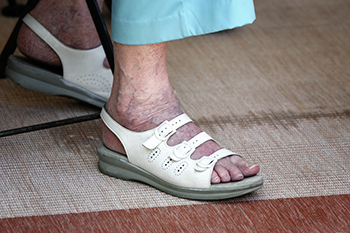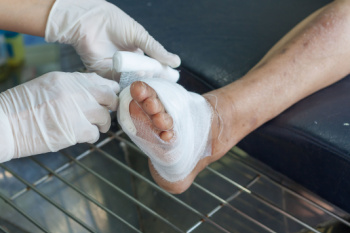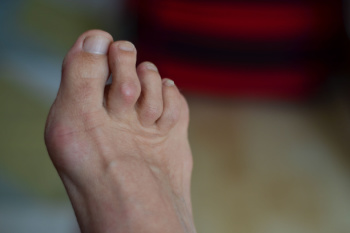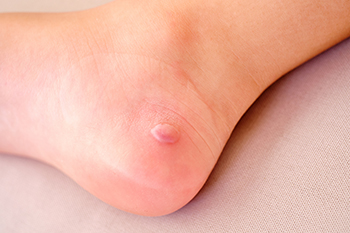Glen Allen Office
(804) 747-3380

Finding the right shoes is vital for managing arthritis that affects the feet. Arthritis, which is an inflammation of the joints, can lead to significant pain and difficulty in walking, especially when it involves the ankle, midfoot, or big toe. It is important to avoid high heels or tight flats, as these can increase discomfort by putting excessive pressure on your feet and misaligning your joints. Instead, look for shoes with a low, thick heel, a wide toe box, and rubber soles that provide cushioning and stability. These features help maintain a natural foot position, reduce pressure on painful joints, and offer the necessary support. Stability shoes, with their cushioned midsole, can also be helpful, particularly for those with arthritis in the foot or ankle. Consulting a podiatrist can ensure you select the best footwear to relieve your arthritis symptoms. If you have arthritis and footwear is a problem, it is suggested that you schedule an appointment with a podiatrist for an exam, diagnosis, and treatment options.
Arthritis can be a difficult condition to live with. If you are seeking treatment, contact one of our podiatrists from The Podiatry Center. Our doctors can provide the care you need to keep you pain-free and on your feet.
Arthritic Foot Care
Arthritis is a term that is commonly used to describe joint pain. The condition itself can occur to anyone of any age, race, or gender, and there are over 100 types of it. Nevertheless, arthritis is more commonly found in women compared to men, and it is also more prevalent in those who are overweight. The causes of arthritis vary depending on which type of arthritis you have. Osteoarthritis for example, is often caused by injury, while rheumatoid arthritis is caused by a misdirected immune system.
Symptoms
Arthritic symptoms range in severity, and they may come and go. Some symptoms stay the same for several years but could potentially get worse with time. Severe cases of arthritis can prevent its sufferers from performing daily activities and make walking difficult.
Risk Factors
If you suspect your arthritis is affecting your feet, it is crucial that you see a podiatrist immediately. Your doctor will be able to address your specific case and help you decide which treatment method is best for you.
If you have any questions, please feel free to contact one of our offices located in Richmond and Glen Allen, VA . We offer the newest diagnostic and treatment technologies for all your foot care needs.
 For diabetic patients, foot care is essential due to the increased risk of complications like infections and ulcers. Start by maintaining good foot hygiene. Wash feet daily with lukewarm water and mild soap, and dry thoroughly, especially between the toes. Moisturize your feet to prevent dryness and cracking, but avoid applying lotion between the toes to reduce the risk of fungal infections. Regularly inspect your feet for cuts, blisters, redness, or swelling, and use a mirror or ask for help if needed. Trim nails carefully, straight across, and file the edges to avoid ingrown toenails. Wear well-fitting, comfortable shoes and clean, dry socks to prevent blisters and sores. Avoid walking barefoot, even at home. If you are a diabetic patient, it is suggested that you schedule regular visits to a podiatrist for professional care and advice. They can manage any developing issues early and provide guidance on proper footwear and orthotics.
For diabetic patients, foot care is essential due to the increased risk of complications like infections and ulcers. Start by maintaining good foot hygiene. Wash feet daily with lukewarm water and mild soap, and dry thoroughly, especially between the toes. Moisturize your feet to prevent dryness and cracking, but avoid applying lotion between the toes to reduce the risk of fungal infections. Regularly inspect your feet for cuts, blisters, redness, or swelling, and use a mirror or ask for help if needed. Trim nails carefully, straight across, and file the edges to avoid ingrown toenails. Wear well-fitting, comfortable shoes and clean, dry socks to prevent blisters and sores. Avoid walking barefoot, even at home. If you are a diabetic patient, it is suggested that you schedule regular visits to a podiatrist for professional care and advice. They can manage any developing issues early and provide guidance on proper footwear and orthotics.
Diabetic foot care is important in preventing foot ailments such as ulcers. If you are suffering from diabetes or have any other concerns about your feet, contact one of our podiatrists from The Podiatry Center. Our doctors can provide the care you need to keep you pain-free and on your feet.
Diabetic Foot Care
Diabetes affects millions of people every year. The condition can damage blood vessels in many parts of the body, especially the feet. Because of this, taking care of your feet is essential if you have diabetes, and having a podiatrist help monitor your foot health is highly recommended.
The Importance of Caring for Your Feet
Patients with diabetes should have their doctor monitor their blood levels, as blood sugar levels play such a huge role in diabetic care. Monitoring these levels on a regular basis is highly advised.
It is always best to inform your healthcare professional of any concerns you may have regarding your feet, especially for diabetic patients. Early treatment and routine foot examinations are keys to maintaining proper health, especially because severe complications can arise if proper treatment is not applied.
If you have any questions please feel free to contact one of our offices located in Richmond and Glen Allen, VA . We offer the newest diagnostic and treatment technologies for all your foot and ankle needs.

Hammer toes, claw toes, or mallet toes are all results of the toes getting bent into odd positions. They usually look odd and can be painful and often affect the smaller toes. When the toe is bent downward and the middle joint raises up, it is known as a hammertoe. Hammertoes normally happen when bunions occur, and they most often affect the second toe. Claw toes occur when the toes curl up because the middle joints are bent down, and they often affect the four smaller toes at the same time. When the joint closest to the tip of the toe bends downward, it forms a mallet toe. Wearing shoes that are too tight is the most common cause of these conditions, but they can also be linked to diabetes or arthritis. These toe conditions are usually painful and can cause other foot problems, like calluses. If you are struggling with one of these deformities, it is suggested you consult with a podiatrist who can offer treatment options and determine if surgery is necessary.
Hammertoes can be a painful condition to live with. For more information, contact one of our podiatrists of The Podiatry Center. Our doctors will answer any of your foot- and ankle-related questions.
Hammertoe
Hammertoe is a foot deformity that occurs due to an imbalance in the muscles, tendons, or ligaments that normally hold the toe straight. It can be caused by the type of shoes you wear, your foot structure, trauma, and certain disease processes.
Symptoms
Risk Factors
Treatment
If you have hammertoe, you should change into a more comfortable shoe that provides enough room for your toes. Exercises such as picking up marbles may strengthen and stretch your toe muscles. Nevertheless, it is important to seek assistance from a podiatrist in order to determine the severity of your hammertoe and see which treatment option will work best for you.
If you have any questions, please feel free to contact one of our offices located in Richmond and Glen Allen, VA . We offer the newest diagnostic and treatment technologies for all your foot care needs.

Playing tennis can be tough on the feet due to the high-impact movements and frequent lateral actions that can often lead to painful blisters. These blisters result from the friction between the skin and footwear, which is inevitable during extended matches. While preventive measures like wearing moisture-wicking socks and properly fitted shoes can reduce the risk, sometimes blisters still develop. When this happens, it may help to consult a podiatrist. This foot doctor can provide professional treatment to alleviate pain and promote healing, ensuring you will not have to pause your tennis activities for long. Specialized padding techniques, specific footwear adjustments, or custom orthotics may be offered to minimize future friction. A podiatrist also can provide personalized advice tailored to your specific foot structure and playing style, which can help prevent blisters from recurring. If you frequently develop blisters on the feet, it is suggested that you schedule an appointment with a podiatrist for effective treatment and prevention methods.
Blisters are prone to making everyday activities extremely uncomfortable. If your feet are hurting, contact one of our podiatrists of The Podiatry Center. Our doctors can provide the care you need to keep you pain-free and on your feet.
Foot Blisters
Foot blisters develop as a result of constantly wearing tight or ill-fitting footwear. This happens due to the constant rubbing from the shoe, which can often lead to pain.
What Are Foot Blisters?
A foot blister is a small fluid-filled pocket that forms on the upper-most layer of the skin. Blisters are filled with clear fluid and can lead to blood drainage or pus if the area becomes infected.
How Do Blisters Form?
Blisters on the feet are often the result of constant friction of skin and material, usually by shoe rubbing. Walking in sandals, boots, or shoes that don’t fit properly for long periods of time can result in a blister. Having consistent foot moisture and humidity can easily lead to blister formation.
Prevention & Treatment
It is important to properly care for the affected area in order to prevent infection and ease the pain. Do not lance the blister and use a Band-Aid to provide pain relief. Also, be sure to keep your feet dry and wear proper fitting shoes. If you see blood or pus in a blister, seek assistance from a podiatrist.
If you have any questions, please feel free to contact one of our offices located in Richmond and Glen Allen, VA . We offer the newest diagnostic and treatment technologies for all your foot care needs.